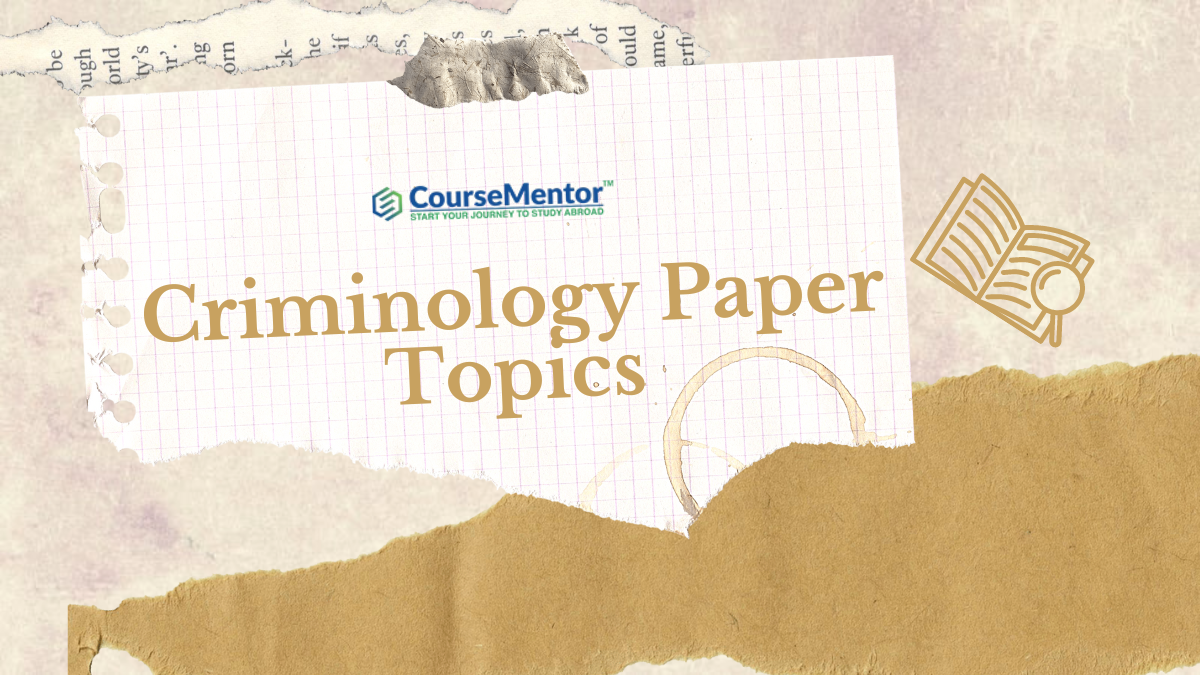Criminology, the study of crime and its causes, is a captivating field that delves into the depths of human behavior and societal structures. If you’re a student or an enthusiast interested in exploring this intriguing subject, you’re in for a treat! In this blog, we’ll journey through the world of criminology paper topics, from understanding its historical roots to exploring contemporary issues and providing valuable tips for selecting your own research topic.
| Also Read: Top 50 Statistics Project Ideas [Revised] |
What Are The 6 Parts Of Criminology?
Criminology, as a multidisciplinary field, encompasses various areas of study. While the exact divisions may vary depending on perspective, six common parts or subfields of criminology include:
- Theoretical Criminology: Examines theories and models explaining the causes and motivations behind criminal behavior.
- Criminal Justice: Focuses on the study of law enforcement, courts, corrections, and the overall criminal justice system.
- Victimology: Investigates the experiences and impacts of crime on victims, including their rights, needs, and support services.
- Criminal Behavior: Analyzes the psychological, sociological, and biological factors influencing individual and group criminal behavior.
- Penology: Explores the punishment and rehabilitation of offenders, including theories of punishment, prison systems, and alternative sentencing methods.
- Comparative Criminology: Compares criminal justice systems, crime rates, and social responses to crime across different countries and cultures.
Top 271 Criminology Paper Topics
- Theoretical Perspectives on Crime Causation
- Trends in Criminal Behavior Over Time
- Impact of Socioeconomic Factors on Crime Rates
- Cybercrime: Challenges and Solutions
- Gender and Crime: Exploring Disparities
- The Role of Genetics in Criminal Behavior
- Criminal Profiling: Myth vs. Reality
- Restorative Justice Approaches in Criminal Law
- White-Collar Crime: Detection and Prevention Strategies
- The Influence of Media on Perceptions of Crime
- Juvenile Delinquency: Causes and Interventions
- Rehabilitation Programs for Offenders
- The Psychology of Criminal Minds
- Police Brutality and Accountability
- Hate Crimes: Causes and Consequences
- Human Trafficking: Modern-Day Slavery
- Drug Policies and Their Impact on Crime Rates
- Mass Incarceration: Effects on Society
- Mental Illness and Criminal Behavior
- Corporate Crime and Accountability
- Domestic Violence: Patterns and Prevention
- Technology and Crime: The Dark Web
- Environmental Criminology: Understanding Crime Hotspots
- Serial Killers: Psychopathy and Motivations
- Gang Violence: Root Causes and Solutions
- Terrorism and Counterterrorism Strategies
- Immigration and Crime: Debunking Myths
- Police-Community Relations: Building Trust
- Criminal Justice Reform: Policy Implications
- Cultural Criminology: Exploring Subcultures
- Victim-Offender Mediation Programs
- Surveillance and Privacy in the Digital Age
- Corruption in Law Enforcement
- Crime Mapping and Spatial Analysis
- School Violence: Prevention and Intervention
- Organized Crime: Structure and Operations
- Psychopathy and Antisocial Personality Disorder
- Gender-Based Violence: Intersectionality Perspectives
- Criminal Justice Responses to Mental Health Issues
- Gun Control Policies and Crime Rates
- Drug Addiction and Crime
- Community Policing Models
- Hate Speech Laws and Freedom of Expression
- Forensic Psychology: Applications in Criminal Cases
- Elder Abuse: Detection and Prevention
- Policing in Minority Communities
- Wildlife Crime: Conservation Challenges
- Political Corruption and Criminal Networks
- Social Media and Cyberbullying
- The Influence of Family Dynamics on Criminal Behavior
- Burglary and Home Security Measures
- Criminal Justice Ethics and Professionalism
- Fear of Crime: Perceptions vs. Reality
- Wrongful Convictions: Causes and Exonerations
- Crime Prevention Through Environmental Design (CPTED)
- Rehabilitation vs. Retribution in Sentencing
- Drug Trafficking Routes and Cartel Operations
- Identity Theft: Prevention and Recovery
- Body-Worn Cameras: Impact on Police Behavior
- Sentencing Disparities Across Racial Groups
- Workplace Violence: Risk Factors and Prevention
- Animal Cruelty and Its Link to Other Crimes
- Cybersecurity Threats and Vulnerabilities
- Legalization of Marijuana: Implications for Crime
- Hate Groups and Extremist Ideologies
- Technology-Facilitated Sexual Violence
- Racial Profiling: History and Contemporary Issues
- The Impact of Incarceration on Families
- Drug Courts: Effectiveness and Challenges
- Trauma-Informed Approaches in Criminal Justice
- Gender Disparities in Sentencing
- Financial Crimes: Fraud and Embezzlement
- Terrorism Financing: Follow the Money
- Criminal Informants: Reliability and Ethical Concerns
- Arson and Fire Investigation Techniques
- The Criminalization of Homelessness
- Witness Protection Programs: Challenges and Successes
- Gun Violence Prevention Strategies
- Human Rights Violations and Transitional Justice
- Cybersecurity Legislation and Policy
- Art Crime: Theft and Repatriation Efforts
- Intimate Partner Homicide: Risk Factors and Prevention
- Hate Crime Legislation: Effectiveness and Enforcement
- Criminal Justice System Response to Mental Health Crises
- Wildlife Trafficking: Impacts on Biodiversity
- Sextortion: Online Exploitation and Blackmail
- Historical Perspectives on Crime and Punishment
- Juvenile Justice Reform Initiatives
- Technological Innovations in Crime Detection
- Environmental Crime: Pollution and Resource Exploitation
- Human Smuggling and Trafficking Networks
- Hate Speech Online: Regulation and Enforcement
- Child Abuse and Neglect: Intervention Strategies
- Corruption in International Organizations
- Social Disorganization Theory and Neighborhood Crime
- False Confessions: Causes and Consequences
- Environmental Justice and Criminal Law
- Online Extremism: Recruitment and Radicalization
- Mental Health Courts: Alternatives to Incarceration
- Wildlife Forensics: Combating Illegal Trade
- Drug Legalization: Pros and Cons
- Gun Trafficking: Interstate and International Networks
- Victim Compensation Programs: Assessing Effectiveness
- Surveillance Technologies: Privacy Concerns
- Gender-Based Violence in Conflict Zones
- Wildlife Conservation and Crime Prevention Partnerships
- The Impact of Economic Inequality on Crime
- Terrorism and Social Media Recruitment Tactics
- Witness Testimony Reliability: Memory and Suggestibility
- The Economics of Crime: Cost-Benefit Analysis
- Terrorism and Refugee Movements
- Community-Based Corrections Programs
- Domestic Violence Legislation: Implementation Challenges
- Hate Crime Victimization and Psychological Effects
- Police Militarization: Implications for Civil Liberties
- Wildlife Forensics: DNA Analysis and Species Identification
- The Role of Religion in Terrorism
- Human Trafficking Victims: Rehabilitation and Support Services
- The Psychology of False Confessions
- Terrorism Financing: Hawala and Informal Banking Systems
- Criminal Justice Responses to Humanitarian Crises
- Mental Health Stigma and Its Impact on Crime Reporting
- Cyberbullying: Prevention and Intervention Strategies
- Wildlife Trafficking Routes and Networks
- The Relationship Between Substance Abuse and Crime
- Forensic Entomology: Using Insects to Solve Crimes
- Terrorism and Media Portrayals: Framing and Bias
- Animal Rights Activism and Civil Disobedience
- Transnational Organized Crime: Drug Cartels and Mafia Networks
- Police Use of Force Policies and Accountability Measures
- Wildlife Trade Regulations and Enforcement
- The Influence of Social Media on Gang Culture
- Psychological Effects of Wrongful Convictions on Innocent Individuals
- Money Laundering: Techniques and Detection Methods
- Victim Blaming in Sexual Assault Cases
- Forensic Anthropology: Identifying Human Remains
- Cybersecurity Threats in Critical Infrastructure
- Gun Violence and Mental Health Policies
- Wildlife Trafficking and Zoonotic Disease Transmission
- Child Soldiers: Rehabilitation and Reintegration Programs
- Forensic Linguistics: Analyzing Language in Criminal Investigations
- Police Reform Initiatives: Community Oversight and Accountability
- Wildlife Conservation Strategies: Community Engagement and Education
- Environmental Crime and Indigenous Communities
- The Impact of Social Media on Juror Bias
- Political Extremism and Hate Crimes
- Wildlife Trafficking and Climate Change
- Drug Abuse Prevention Programs in Schools
- Wildlife Crime Investigations: Challenges and Solutions
- The Psychological Impact of Cyberbullying on Adolescents
- Hate Crimes Against LGBTQ+ Individuals: Legal Protections and Challenges
- Financial Investigations: Tracing Illicit Funds
- Wildlife Trafficking and Corruption in Developing Countries
- The Role of Forensic Science in Solving Cold Cases
- Police Body Cameras: Transparency and Accountability
- Wildlife Trafficking and Biodiversity Loss
- The Influence of Gang Culture on Youth Violence
- Cyberstalking: Legal Responses and Protections
- Forensic Botany: Plant Evidence in Criminal Investigations
- Community Policing and Trust-Building Initiatives
- Wildlife Conservation and Indigenous Rights
- The Psychology of Mass Shooters
- Cybersecurity and National Security Threats
- Wildlife Trafficking and Public Health Risks
- The Impact of Parental Incarceration on Children
- Cyberbullying Prevention Programs in Schools
- Wildlife Trafficking and Tourism
- The Intersection of Mental Health and Homelessness
- Cybersecurity and Supply Chain Vulnerabilities
- Wildlife Trafficking and Wildlife Tourism
- The Influence of Social Media on Gang Recruitment
- Wildlife Trafficking and Economic Development
- The Relationship Between Gangs and Organized Crime
- Cybersecurity and the Internet of Things (IoT)
- Wildlife Trafficking and Transnational Crime Networks
- The Impact of Gang Violence on Communities
- Cybersecurity and Insider Threats
- Wildlife Trafficking and Corruption in Law Enforcement
- The Role of Technology in Gang Warfare
- Cybersecurity and Ransomware Attacks
- Wildlife Trafficking and International Trade
- The Psychological Effects of Gang Membership
- Cybersecurity and Cyber Warfare
- Wildlife Trafficking and Terrorism Financing
- The Impact of Gang Injunctions on Communities
- Cybersecurity and Social Engineering Attacks
- Wildlife Trafficking and Conservation Efforts
- The Role of Religion in Gang Culture
- Cybersecurity and Identity Theft
- Wildlife Trafficking and Ecotourism
- The Influence of Family Dynamics on Gang Involvement
- Cybersecurity and Data Breaches
- Wildlife Trafficking and Wildlife Crime Legislation
- The Psychological Effects of Cyberbullying on Victims
- Cybersecurity and Phishing Attacks
- Wildlife Trafficking and Endangered Species Protection
- The Impact of Gang Violence on Youth
- Cybersecurity and Malware
- Wildlife Trafficking and Environmental Sustainability
- The Role of Schools in Gang Prevention
- Cybersecurity and Advanced Persistent Threats (APTs)
- Wildlife Trafficking and International Cooperation
- The Influence of Peer Pressure on Gang Affiliation
- Cybersecurity and Distributed Denial of Service (DDoS) Attacks
- Wildlife Trafficking and Wildlife Trafficking Laws
- The Role of Social Media in Gang Recruitment
- Cybersecurity and Cyber Espionage
- Wildlife Trafficking and Animal Welfare
- The Impact of Poverty on Gang Involvement
- Cybersecurity and Insider Threat Detection
- Wildlife Trafficking and Cross-Border Cooperation
- The Influence of Media Portrayals on Gang Culture
- Cybersecurity and Cloud Security
- Wildlife Trafficking and International Agreements
- The Role of Mentors in Gang Prevention
- Cybersecurity and Encryption
- Wildlife Trafficking and Community Engagement
- The Impact of Trauma on Gang-Involved Youth
- Cybersecurity and Mobile Security
- Wildlife Trafficking and Sustainable Development
- The Influence of Trauma on Criminal Behavior
- Cybersecurity and Network Security
- Wildlife Trafficking and Public Awareness Campaigns
- The Role of Social Support Systems in Rehabilitation
- Cybersecurity and Internet Security
- Wildlife Trafficking and Wildlife Rehabilitation
- The Impact of Childhood Adversity on Criminality
- Cybersecurity and Cyber Hygiene
- Wildlife Trafficking and Wildlife Rescue
- The Influence of Peer Pressure on Criminal Behavior
- Cybersecurity and Endpoint Security
- Wildlife Trafficking and Habitat Conservation
- The Role of Early Intervention Programs in Crime Prevention
- Cybersecurity and Information Security Policies
- Wildlife Trafficking and Wildlife Monitoring
- The Impact of Trauma-Informed Care on Rehabilitation
- Cybersecurity and Incident Response
- Wildlife Trafficking and Wildlife Sanctuaries
- The Influence of Childhood Attachment on Criminality
- Cybersecurity and Security Awareness Training
- Wildlife Trafficking and Community-Based Conservation
- The Role of Parental Supervision in Crime Prevention
- Cybersecurity and Cyber Insurance
- Wildlife Trafficking and Wildlife Rehabilitation Centers
- The Impact of Substance Abuse on Criminal Behavior
- Cybersecurity and Cybersecurity Regulations
- Wildlife Trafficking and Wildlife Protection Organizations
- The Influence of Social Media on Criminal Behavior
- Cybersecurity and Cybersecurity Standards
- Wildlife Trafficking and Wildlife Crime Prevention Agencies
- The Role of Peer Networks in Criminal Socialization
- Cybersecurity and Cybersecurity Frameworks
- Wildlife Trafficking and Wildlife Conservation Organizations
- The Impact of Educational Attainment on Criminality
- Cybersecurity and Incident Response Plans
- Wildlife Trafficking and Wildlife Rescue Organizations
- The Influence of Cultural Factors on Criminal Behavior
- Cybersecurity and Cybersecurity Risk Management
- Wildlife Trafficking and International Wildlife Trade Agreements
- The Role of Mental Health in Criminal Behavior
- Cybersecurity and Cybersecurity Risk Assessments
- Wildlife Trafficking and Wildlife Law Enforcement Agencies
- The Impact of Poverty on Criminal Behavior
- Cybersecurity and Cybersecurity Risk Analysis
- Wildlife Trafficking and Wildlife Rehabilitation Organizations
- The Influence of Peer Pressure on Criminal Decision-Making
- Cybersecurity and Cybersecurity Risk Mitigation
- Wildlife Trafficking and Wildlife Protection Laws
- The Role of Social Support Networks in Rehabilitation
- Cybersecurity and Cybersecurity Risk Strategies
- Wildlife Trafficking and Wildlife Trafficking Prosecution Efforts
Tips for Selecting and Developing Criminology Paper Topics
Conduct a Literature Review
Start by researching existing literature in the field of criminology. Look for gaps in research, unresolved debates, or emerging areas of interest. This will help you identify potential topics that are both relevant and underexplored.
Consider Your Interests
Choose a topic that genuinely interests you. Your passion for the subject will not only make the research process more enjoyable but also enhance the quality of your paper. Reflect on your personal experiences, academic background, or career aspirations to find a topic that resonates with you.
Narrow Down the Scope
Criminology covers a lot of different areas. To make your paper clearer, pick one part of criminology you’re really interested in. This way, you can study it more deeply and write a paper that’s easier to understand.
Formulate a Clear Research Question
Once you’ve selected a topic, formulate a clear and concise research question. Your research question should be specific, relevant, and capable of being answered through empirical investigation. It should guide your research and provide a framework for your paper.
Consider Ethical Implications
Be mindful of the ethical implications of your research topic, especially if it involves sensitive or controversial issues. Ensure that your research is conducted ethically and that the rights and well-being of research participants are protected.
Consult with Experts
Ask your teachers, mentors, or friends who know a lot about criminology for help. They can give you good ideas, recommend useful books and articles, and assist you in making your research topic better. Don’t be afraid to ask experts for advice and encouragement.
Stay Updated on Current Events
Keep abreast of current events, trends, and developments in the field of criminology. Pay attention to news articles, academic journals, and policy reports that may inspire new research topics or provide real-world context for your paper.
Be Flexible and Open-Minded
Remain flexible and open-minded throughout the research process. Your initial research topic may evolve as you delve deeper into the literature or encounter new information. Embrace this process of exploration and adaptation, and be willing to revise your topic if necessary.
Conclusion
Criminology is a dynamic field that offers endless opportunities for exploration and discovery.
By understanding its historical roots, exploring contemporary issues, and following best practices for selecting and developing criminology paper topics, you can embark on a fascinating journey into the world of crime and criminal justice.
So, whether you’re a student or a curious enthusiast, don’t hesitate to dive deep into the realm of criminology and uncover the secrets of human behavior and societal dynamics.





